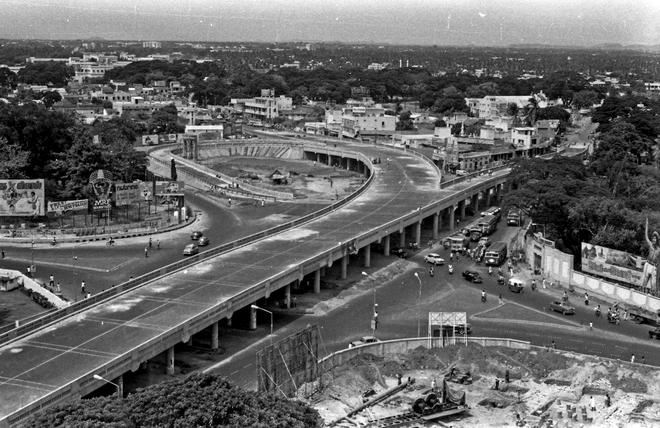
Chennai’s important landmark — Anna Flyover or Gemini Flyover — which has withstood the test of time and changes in the city, turns 50 on July 1.
Exactly 50 years ago (July 1, 1973), the then Chief Minister M. Karunanidhi declared open the flyover, then the longest flyover in the country at 1,599 ft. in length and 48 ft. in width. Built over what was earlier called the Gemini Circle, marking the junction of Mount Road, Cathedral Road and Nungambakkam High Road, the facility, which links G.N. Chetti Road of T. Nagar too, was constructed at a cost of ₹66 lakh and was completed in 21 months. East Coast Constructions and Industries, based in Chennai, executed the project.
According to an advertisement insertion published in The Hindu on the inauguration day, the Corporation of Madras (now called Greater Chennai Corporation) had mooted a proposal around 1948-49. The mid-1960s saw a renewed interest in the proposal and in December 1969, the DMK regime sanctioned the flyover project at a cost of ₹49.5 lakh. By then, Karunanidhi had become the Chief Minister.
In the run-up to the execution of the flyover, its design underwent certain changes.
A news report published by The Hindu on July 23, 1971, stated that “in the previous plan, no access ramp was provided from G.N. Chetti Road to link up with the flyover and there was no “clover leaf” curved path.
The original design has been revised to provide for freer flow of traffic from G. N. Chetti Road to Mount Road and vice versa.”
Re-routing of mains
It added that “largescale re-routing of water mains, sewers and cables, envisaged in the earlier plan has now been avoided.”
Thirty-eight years later, another news article on the flyover referred to the deployment of a bridge deck system that used multiple hollow block slabs made of pre-cast elements.
When the flyover construction was approaching completion, Karunanidhi had made the announcement that the flyover would be named after the founder of the DMK and former Chief Minister C.N. Annadurai, whose bust can be spotted below the flyover on the Cathedral Road-Nungambakkam High Road section.
At the inaugural event, Karunanidhi also announced that landmarks and roads in the city, bearing the names of Britishers, would be, in a phased manner, named after celebrated Indians.
In 1974, two statues of a man reigning in horses were installed on two sides of the flyover to remember the government’s decision then to abolish racing. In September 1977, the then Defence Minister Jagjivan Ram unveiled the statue of Dravida Kazhagam founder, E.V. Ramasamy, in the presence of the then Chief Minister M.G. Ramachandran.
Talking of Karunanidhi’s attachment to the landmark, M.S. Srinivasan, who served the State Highways Department during 1962-1997 and who later worked as Advisor (Roads) in the State government and Tamil Nadu Urban Infrastructure Financial Services Lt. (TNUIFSL), recalls that during 2009-10, he attended a meeting chaired by Karunanidhi, who was the then Chief Minister, to finalise the details of the early phase of Chennai Metro Rail project. “He categorically told us — you are free to do anything to get the project implemented but you have to ensure that no damage is caused to the flyover.”
A senior official of the Highways department points out that the flyover remains “structurally sound” and there is “no contact” between the structure and the underground section of the Metro Rail. In 2017, it was estimated that around two lakh vehicles passed through the flyover every day.
After M.K. Stalin became Chief Minister in May 2021, the State government announced that it would take up renovation of the flyover. Being executed at a cost of ₹8 crore, the work — landscaping, beautification of pillars and a complete painting — are expected to be completed in a month, the official says.
In the years to come, the city will witness many more changes. Yet, the flyover will retain its place of importance.







